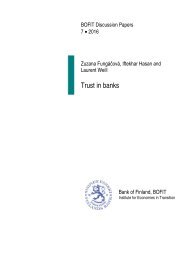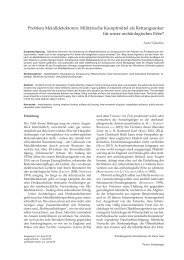Media and Minorities
9783666300882_ruhrmann_media_ebook_034247
9783666300882_ruhrmann_media_ebook_034247
Create successful ePaper yourself
Turn your PDF publications into a flip-book with our unique Google optimized e-Paper software.
Creating an Inclusive Public Commons 57<br />
overlook the very social conditions <strong>and</strong> outcomes that a journalist intends<br />
to highlight.<br />
Research in experimental psychology has found that journalism that relies<br />
on the anecdotal frame may increase the audience’s feeling that a non-majority<br />
individual is the “other.”25 The news story focuses one’s attention on an<br />
individual’s behavior <strong>and</strong> choices. This in turn may prompt an audience to<br />
blame the victim, if you will, or attribute inequities in health, for instance, to<br />
cultural practices or group behaviors of the less healthy instead of holding the<br />
society at large accountable.<br />
News stories on health inequities often feature individuals who have become<br />
health advocates. For example, an article in the Savannah Morning<br />
News described an African-American woman who having survived breast<br />
cancer had begun promoting mammograms for women in her community.26<br />
On the whole, the story was fine. But, by emphasizing this individual’s experience,<br />
the writer suggested that fear <strong>and</strong> financial worries prevent black women<br />
from getting tested <strong>and</strong> that, as a result, we see a higher death rate among African-American<br />
women with the disease. Like many other such articles, it also<br />
pointed to contested evidence that supposedly links certain types of African<br />
ancestry to an especially aggressive type of breast cancer. However, the article<br />
didn’t mention what may be an equally important, perhaps even more important,<br />
factor in the increased death rate that has nothing to do with an individual’s<br />
decision making or ancestry. There is convincing evidence that Afri<br />
can-American women receive lower quality health care over their lifetimes.27<br />
Another article, on a website called Healthy Hispanic Living, is like many<br />
that aim to empower Latinas to take steps to lower their risk of breast cancer.<br />
In the course of recommending screenings <strong>and</strong> self-exams, the site’s content<br />
speculates that there is something biologically distinct about this very diverse<br />
group, whose members come from Spain, Mexico, Central <strong>and</strong> South America,<br />
<strong>and</strong> the Caribbean, that leads to high susceptibility. In fact, there is no scientific<br />
agreement on this hypothesis.28<br />
Such reporting turns society’s attention to individual or supposed group<br />
characteristics that cannot be changed <strong>and</strong>, thus, away from solutions that can<br />
25 Mahzarin Banaji, personal communication, 2006.<br />
26 Dana Clark Felty, “Black Women & Breast Cancer: Lower Risk, Greater Danger,” Savannah<br />
Morning News, 30 March 2010, http://savannahnow.com/accent/2010-03-30/black-womenbreast-cancer-lower-risk-greater-danger.<br />
27 Jeffrey H. Silber et al., “Characteristics associated with differences in survival among<br />
black <strong>and</strong> white women with breast cancer,” JAMA 310, no. 4 (2013): 389–397, doi:10.1001/<br />
jama.2013.8272.<br />
28 Laura Fejerman et al., “Genome-Wide Association Study of Breast Cancer in Latinas<br />
Identifies Novel Protective Variants on 6q25,” Nature Communications 5 (2014): 1–8,<br />
doi:10.1038/ncomms6260.<br />
© 2016, V<strong>and</strong>enhoeck & Ruprecht GmbH & Co. KG, Göttingen<br />
ISBN Print: 9783525300886 — ISBN E-Book: 9783666300882







